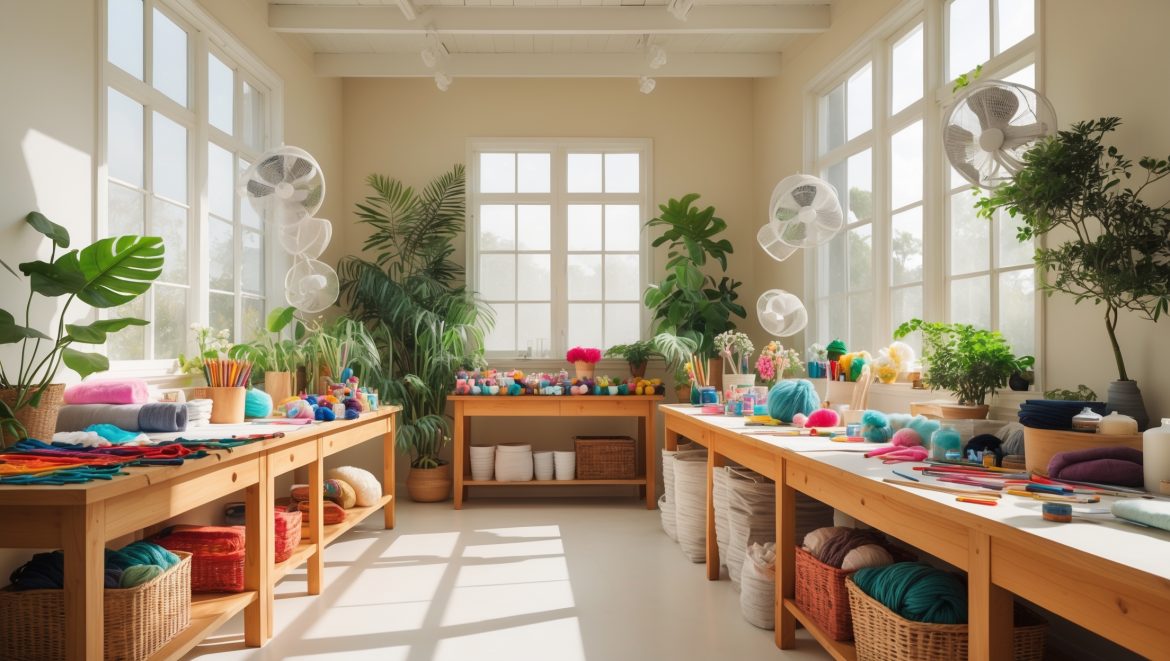Introduction: Why Ventilation Matters in Your DIY Craft Studio
When setting up a DIY craft studio, most creators focus on storage, lighting, and workspace layout. But ventilation is often overlooked—even though it’s a cornerstone of both safety and comfort. Adequate airflow protects you from inhaling dust, fumes, and airborne particles generated by paints, glues, solvents, wood, and even fabric fibers. Without proper ventilation, your creative haven can become a source of headaches, allergies, and long-term health risks. Effective ventilation also helps control humidity, prevents mold growth, and keeps your space feeling fresh, especially during long creative sessions or when working with strong-smelling materials.
In this comprehensive guide, you’ll learn how to assess your craft studio’s ventilation needs, compare practical options for every budget, calculate costs, and implement solutions for both small and large spaces. Whether you’re a paper crafter, woodworker, resin artist, or textile creator, these actionable steps will help you breathe easy while you create. Let’s explore how to transform your studio into a safer, more inspiring space—without breaking the bank or sacrificing your workflow.
Assessing Your Studio’s Ventilation Needs
Identify Common Air Quality Risks in Crafting
Start by listing the materials and techniques you regularly use. Consider:
- Paints, spray paints, inks, and dyes
- Solvents, glues, resins, and adhesives
- Woodworking dust, sanding, and cutting
- Textile fibers, lint, and threads
- Laser cutters, soldering, or other heat-based tools
Each introduces specific airborne risks, from volatile organic compounds (VOCs) to fine particulate matter. Even low-odor, “non-toxic” products can build up in closed environments, especially during extended use.
Evaluate Your Space
- Room Size: Small rooms build up contaminants faster.
- Window Placement: Windows on opposite walls allow for natural cross-ventilation.
- Existing HVAC: Central systems may not be sufficient or may circulate dust.
- Sealing: Well-sealed rooms (great for insulation) often need mechanical ventilation.
Sketch your floor plan and note entry points for fresh air (windows, doors, vents) and exhaust (fans, existing vents).
Simple Airflow Test
On a moderately windy day, open a window or door and place a small strip of tissue near each vent or opening. If the tissue barely moves, your airflow is minimal. For a more precise test, use an inexpensive handheld anemometer or a basic smoke pencil to trace airflow patterns.
Ventilation Methods: Options for Every Studio
Natural Ventilation
Utilizing windows and doors is the simplest and most cost-effective strategy. For best results:
- Open windows on opposite sides to create a cross-breeze.
- Install window stops to control and secure airflow, especially for safety.
- Use box fans in windows to exhaust air outward.
- Rotate your workspace to avoid sitting directly in drafts.
Limitations: Not effective during extreme weather, in windowless rooms, or when working with hazardous fumes.
Mechanical Ventilation
For consistent, controlled airflow—especially in basement or interior studios—mechanical ventilation is essential.
- Exhaust Fans: Wall-mounted or window exhaust fans actively pull contaminated air out. Choose models rated for your room’s cubic footage (CFM rating).
- Inline Duct Fans: Ideal for venting air through a wall or ceiling to the outdoors. Can be paired with flexible ducting to reach outside.
- Range Hoods: Ducted range hoods (not recirculating) over workbenches capture fumes and particles at the source.
Always vent to the exterior. Avoid venting into attics or crawlspaces, as this redistributes contaminants.
Air Purifiers and Filtration
HEPA air purifiers help capture fine dust, pollen, and some VOCs, but they do not replace the need for fresh air exchange. Choose units rated for your room size, and opt for models with activated carbon filters to help reduce odors and chemical vapors.
DIY Ventilation Upgrades
- Install a window-mounted fan facing outward to exhaust air during projects.
- Construct a portable fume hood using a clear plastic bin, a small exhaust fan, and flexible ducting vented outdoors—perfect for resin, soldering, or spray paint.
- Use oscillating fans to keep air moving, but always combine with an exhaust system to prevent just recirculating contaminants.
Ventilation for Specific Crafts
- Woodworking: Combine dust collection (shop vacs, cyclones) with an exhaust fan to remove fine particulates.
- Painting & Resin: Use local exhaust (hoods or window fans) at your workbench. Wear a respirator during heavy use.
- Textiles & Sewing: Regular vacuuming and HEPA filtration reduce lint and fibers, but open windows periodically to bring in fresh air.
Cost Breakdown: Budget-Friendly to Premium Solutions
Entry-Level (Under $100)
- Box fan: $20–$50
- Window stops/safety locks: $10–$20
- Basic oscillating fan: $25–$40
- Reusable air filters for windows: $15–$30
Great for seasonal use or when starting out in a well-windowed room.
Mid-Range ($100–$400)
- Window exhaust fan: $60–$120
- HEPA air purifier: $100–$300 (room size dependent)
- DIY fume hood materials: $40–$80
- Inline duct fan + flexible ducting: $80–$200
Provides year-round capability and more targeted air quality control.
Premium Solutions ($400+)
- Installed wall/ceiling exhaust system: $400–$1,000+ (parts & labor)
- Industrial dust collection system for large woodworking shops: $800–$2,500
- Commercial-grade ducted fume hoods: $700–$2,500+
Ideal for high-volume studios, professional crafters, or those working with hazardous materials.
Step-by-Step: Setting Up Effective Studio Ventilation
1. Plan Airflow Pathways
Map out where fresh air will enter and contaminated air will exit. If using a fan, position it to pull air across your main work area and out of the room.
2. Install Exhaust Equipment
For window fans: Secure the fan in a window with foam strips or weather sealing to prevent backflow. For wall fans or ducted systems, carefully cut the vent opening, install the fan, and seal all edges with caulk or weatherproof tape.
3. Add Air Purification (If Needed)
Place your HEPA purifier near your work area but away from direct air outflows, allowing it to capture airborne particles before they settle.
4. Test and Adjust
Use a smoke pencil, incense, or a strip of tissue to test airflow direction and speed. Adjust fan speed or vent placement as needed.
5. Maintain Filters and Fans
Check and replace filters (in purifiers, window fans, and HVAC) per manufacturer guidelines. Wipe down fan blades and air intake areas monthly.
Maintenance and Safety Checklist
- Clean or replace air filters (HEPA, carbon, HVAC) every 1–3 months.
- Vacuum dust and lint from fan grilles and vents monthly.
- Inspect ductwork and vents for blockages or leaks every 6 months.
- Never block exhaust vents or over-crowd fans with tools or materials.
- Keep chemicals, paints, and solvents tightly sealed when not in use.
- Install a carbon monoxide detector if using any gas appliances or soldering equipment.
Frequently Asked Questions
How often should I ventilate my craft studio?
Ideally, run your exhaust fan or open windows during and for at least 30 minutes after any project involving paint, glue, or dust. For general use, ventilate daily to maintain fresh air.
Can I use a bathroom exhaust fan?
Bathroom fans can work for very small studios, but they’re often underpowered for workshops. Check the CFM rating and compare to your room’s size.
Is it safe to use a recirculating range hood or purifier alone?
No. Recirculating devices do not remove fumes from the room—they only filter some particles and odors. Always pair with an exterior vent or open window.
Conclusion: Breathe Easy, Create Freely
Crafting is about joy, expression, and making something from nothing. But the materials and techniques that fuel our creativity can also introduce invisible risks to our health and comfort if proper ventilation is neglected. By understanding your studio’s specific needs and implementing a tailored ventilation plan—whether it’s as simple as opening a window and using a fan, or as robust as installing dedicated exhaust and filtration systems—you protect both your well-being and the quality of your finished projects.
Remember, investing in clean air pays dividends in focus, energy, and long-term health. Proper ventilation prevents headaches, allergic reactions, and chronic issues, all while preserving the freshness of your workspace and the vibrancy of your materials. With practical solutions for every budget and studio size, there’s no reason to let air quality be an afterthought. Take a few hours to audit your setup, make necessary upgrades, and establish maintenance routines. Soon, you’ll find that a well-ventilated studio isn’t just safer—it’s a more inspiring, productive sanctuary for your creative journey.
Ready to breathe easy? Start today, and let your imagination flow freely in the healthiest way possible.


